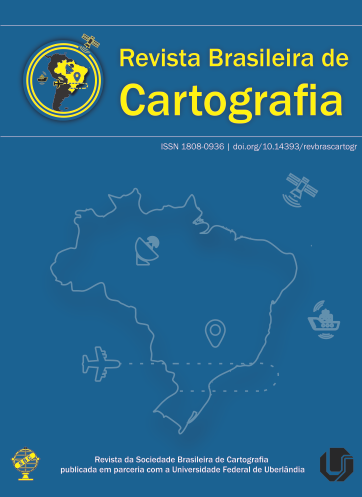Contribuição de Aspectos Naturais e Antropogênicos para Análise do Perigo à Inundação em Campinas-SP
Conteúdo do artigo principal
Resumo
As inundações são fenômenos naturais, que podem causar impacto ambiental conforme as alterações de cobertura e uso do solo, com a intensificação demográfica e crescimento urbano. Assim, o propósito deste estudo foi incluir a relação entre os sistemas naturais e antrópicos na elaboração dos modelos de análise do perigo à inundação. A partir de análise espacial foram gerados modelos de perigo à inundação, empregando o método de sobreposição ponderada e a análise pareada de critérios pelo Processo Analítico Hierárquico (AHP), considerando os parâmetros hipsometria, densidade, tipos de solos, densidade de drenagem, pluviometria, tipos de solos, cobertura vegetal original e uso e cobertura, nas datas 1975 e 2018. As classes de uso e cobertura do solo (urbano, agrícola, solo exposto, vegetação arbórea e rasteira, água e outros) foram obtidas pelo processo de classificação por regiões das imagens LANDSAT, utilizando o classificador por máxima verossimilhança. Observou-se alterações das classes Alto e Muito Alto, ao comparar as alterações entre os modelos de perigo natural e antropogênico à inundação de 1975 e de 2018, que passaram a ocupar 225,7km² (28,63%) e 26,59km² (3,37%) em 1975, e 260,97km² (33,09%) e 22,88km² (2,90%) em 2018. Destaca-se que as maiores alterações das áreas de perigo Alto foram observadas nas bacias do Rio Capivari de 34,3km² (1975) e 56,8km² (2018), Ribeirão Anhumas de 28,4km² (1975) e 35,4km² (2018), Ribeirão Quilombo de 14,1km² (1975) e 22,8km² (2018), e Rio Atibaia 20,6km² (1975) e 13,4km² (2018). Atribui-se a variação do perigo alto de inundação nessas bacias ao adensamento populacional e impermeabilização do solo, como consequência da expansão urbana em áreas de planícies fluviais, que alteram o escoamento e infiltração das águas superficiais.
Downloads
Detalhes do artigo
Seção

Esta obra está licenciado com uma Licença Creative Commons Attribution 3.0 Unported License.
Autores que publicam nesta revista concordam com os seguintes termos:
- Autores mantém os direitos autorais e concedem à revista o direito de primeira publicação, com o trabalho simultaneamente licenciado sob a Licença Creative Commons Atribuição que permite o compartilhamento do trabalho com reconhecimento da autoria e publicação inicial nesta revista.
- Autores têm autorização para assumir contratos adicionais separadamente, para distribuição não-exclusiva da versão do trabalho publicada nesta revista (ex.: publicar em repositório institucional ou como capítulo de livro), com reconhecimento de autoria e publicação inicial nesta revista.
- Autores têm permissão e são estimulados a publicar e distribuir seu trabalho online (ex.: em repositórios institucionais ou na sua página pessoal) a qualquer ponto antes ou durante o processo editorial, já que isso pode gerar alterações produtivas, bem como aumentar o impacto e a citação do trabalho publicado (veja "O Efeito do Acesso Aberto").





